An official account of all species that have been recorded and reported by birdwatchers and naturalists in the Poole Harbour area since records began.
The data for this list has been extracted from various sources, but George Greens 'The Birds of Dorset', Mansel-Pleydell's Birds of Dorsetshire, Naylor’s reference manual of rare birds and the back catalogue of Dorset bird reports have provided most information. Data is currently still being researched and records will be updated accordingly.
You can view this information in two different ways. Our alphabetical list provides information on the status of each species within the harbour, finder dates and names, photos and favoured locations. By clicking on the Systematic List button you will be presented the full Poole Harbour systematic list which includes status of species, pending records and historical accounts.
To date, 333 species have occurred and have been accepted within the Birds of Poole Harbour boundaries. A further 11 distinct subspecies have also been seen. In addition, we have two species/subspecies which have been recorded, but are awaiting acceptance by the appropriate records panel.
There are a handful of historical records, for which there is currently insufficient information to allow their inclusion onto the Poole Harbour list, but are believed to be genuine records. They are listed at the end of the list.
Finally, there are a number of feral or escaped species that have been recorded within the Birds of Poole Harbour boundaries. They are included for completeness, but are not included on the Poole Harbour list.
We would be interested in hearing details of any species that do not appeared on this list.
The Birds of Poole Harbour systematic list is a PDF which you can view by clicking on the button below. It was last updated on December 2019.
Full Poole Harbour Systematic List
Baird’s Sandpiper
Latin Name
Calidris bairdii
Status
Vagrant
Site And Records Information
Poole Harbour has a good record for attracting rare North American vagrant waders but it certainly took a long time for Baird’s Sandpiper to finally get added to the Poole Harbour list with just one record. As is the case for most wader ‘firsts’ in Poole harbour, Brownsea played host to the only record
1 on 1st – 16th Sept 2017. Just one Poole Harbour record of a juvenile found on the Brownsea Lagoon September 2017. It fed on algae mats and the far shoreline of the lagoon (P.Morton et al.)
Balearic Shearwater
Latin Name
Puffinus mauretanicus
Status
Passage Migrant
Site And Records Information
Very scarce visitor but almost annual with the first definite record of one past Branksome Chine on 3rd September 1997. Luckily this bird and others subsequently have decided to do a few circuits around Poole Bay allowing many people to successfully add them to their Poole harbour lists.
Other records include 1 on 7th September 1998, another on 31st August 1998 and 6 were seen off Branksome Chine and Studland Bay between 3rd Jul and 3rd Nov 2000. 2 others were seen off Branksome Chine on 2nd March 2002 which the earliest spring record for the county.
Like most sea watches in Poole Bay, a decent SSE wind will push Balearic Shearwater closer into Branksome Chine. The most recent record is of 3 west on August 20th 2020
There’s also a record of one inside Poole Harbour on 2nd Oct 1977
Recent Records
Branksome Chine – 1 on 20th August and 2 on 26th August 2015
Studland Bay – 1 on 20th August past Pilots Point and 2 on the 21st August 2015
2017
1 on 3rd Aug 2017 from Ballard Down
1 on 3rd Sep 2017 from Branksome Chine
2019
1+ on 14th Aug and 2 on 16th Aug 2019 from Branksome Chine
2020
3 on 21st Aug 2020 from Branksome Chine
2023
2 on 20th Sep 2023 from Branksome Chine
Bar-tailed Godwit
Latin Name
Limosa lapponica
Status
Passage Migrant & Winter Visitor
Site And Records Information
Nowhere near as common as Black-tailed Godwit, but still reliably seen feeding or roosting on the mud off shore road, moving to Brownsea if disturbed by windsurfers or bait diggers. Average totals of 60-100 with birds frequenting the shores of Furzey, Middlebere and Arne through the winter. Obvious passage can be observed out in Poole Bay during April with birds heading back to their breeding grounds. The birds passing in spring are a different race to the birds that winter in the harbour.
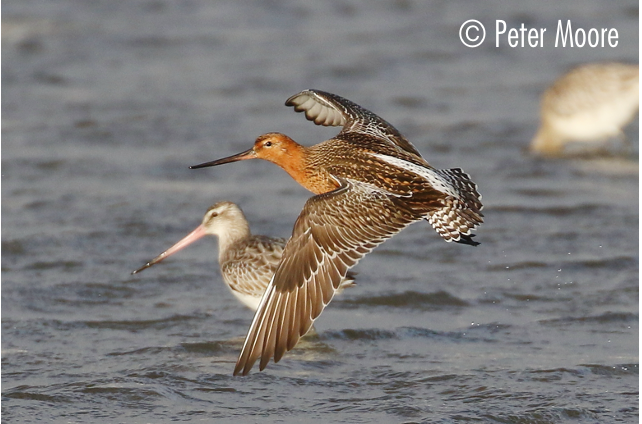
Barn Owl
Latin Name
Tyto alba
Status
Resident
Site And Records Information
Bred recently at Arne and Middlebere, but during severely cold winter birds from further afield can occur anywhere around the harbour in the search for food. Unfortunately it has declined as a breeding species with up to 5 pairs around 10-15 years ago. A bird that was ringed as a chick at Shapwick in 2011 was recently re-seen at Sunnyside farm in the west of the harbour. Now also breeds at Ridge, Worgret, Swineham and Greenlands Farm
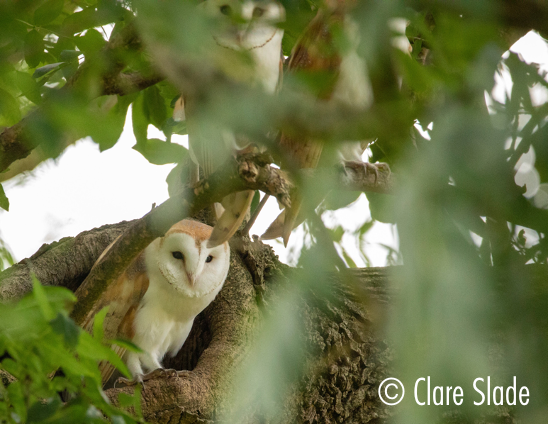
Barnacle Goose
Latin Name
Branta leucopsis
Status
Feral & Winter Visitor
Site And Records Information
Most sightings in the harbour relate to feral individuals that mixed with Canada Geese. A small feral flock was regularly reported in Poole Harbour from 1978 to at least 1986 reaching a maximum of 9 at Poole Park on 12th Jan 1985. In 2014, 2 were with a flock visiting sites in the north of the harbour.
There are recent good examples of birds that were considered to be wild.
In Dec 2010 a very cold spell of snowy weather drew a flock of 42 to Brands Bay on 6th. They remained until 8th before deciding that the fields of Lytchett Bay were a far more attractive proposition. They remained here from 12th Dec until 14th Jan 2011.
In Dec 2011 12 flew through Lytchett Bay on 17th, before 13 were found at Middlebere on the 18th. 4 continued to be seen until 21st Feb 2012 at various sites in the southern harbour. It is likely that remainder of these birds moved on to join the wintering flock at The Fleet which was established at the time.
On 17th Feb 2013 20 flew NE over Lytchett Bay at dusk. It was considered that these were from the wintering flock in the Fleet at the beginning of their return migration.
On April 29th 1 at Swineham and Keysworth and 2 at Lytchett Bay on Aug 22nd, 4th and 11th Oct 2014
On 20th November 2015 25 flew east over Littlesea, Studland
On 6th January 2015 one was in Poole Park
On 22nd November 12 went west over Poole Town, Constitution Hill Road
On 24th November 2016 24 were settled in Lytchett Bay during the morning
On 10th October 2018 10 flew over Sunnyside Farm (B.Whally)
24 on 24th Nov 2016 (seen later same day in Devon) and 22 on 26th Dec 2016 at Lytchett Fields RSPB
22 on 27th Nov 2017 at Swineham GP, also seen on 3rd & 15th Dec 2017
12 on 30th Oct 2017 at Arne RSPB, which later moved to Swineham GPs.
14 near Green Island on 26th January 2017, settling at Rempstone on 27th & 28th Jan 2017. 1 in the Middlebere Channel on 27th Oct 2017.
14 on 1st Jan and 12 on 3rd Jan at Swineham GP. A minimum of 11 on various dates between 30th Jan and 12th Mar 2017, rising to 14 on 7th Feb 2017. 13 birds present on 30th & 31st Oct 2017 at Swineham GPs .
2020
35 flew S from Brownsea Island on 27th May 2020; singles at Middlebere on 18th Aug 2020, Little Sea on 31st Aug 2020 and from a bird boat on 11th Dec 2020
1 on 27th Sep, 21st, 22nd & 28th Nov and 11th, 12th, 15th & 20th Dec 2020 all at Swineham
Singles at Holme Lane, Bog Lane Greenspace on 14th Dec 2020, Lytchett Bay, 27th Sep 2020 and Wareham Common 3rd Jun 2020.
A site record of 50 circled over Lytchett Bay on Jan 10th 2021.
Otther single records from 2021 included 1 off Redhorn on Feb 10th, Ower Bay Feb 16th, Brownsea Lagoon April 1st , Lytchett Bay June 3rd, Swineham GP Nov 15th. There were also 5 in Brands Bay on October 21st.
2023
Poole Harbour 1 on 5th Feb.
Spring:
Poole Harbour Singles reported on several dates from 8th Apr to 21st May.
Sunnyside Farm Singles on 16th & 21st Apr and 1st May.
Swineham GPs 1 from 6th Apr to 15th May and 4 on 13th Apr.
Autumn:
Holme Lane GP Singles on seven dates from 11th Jul to 26th Aug.
Second winter period:
Bog Lane Greenspace 1 on 11th Nov.
Holmebridge 1 on 16th Dec
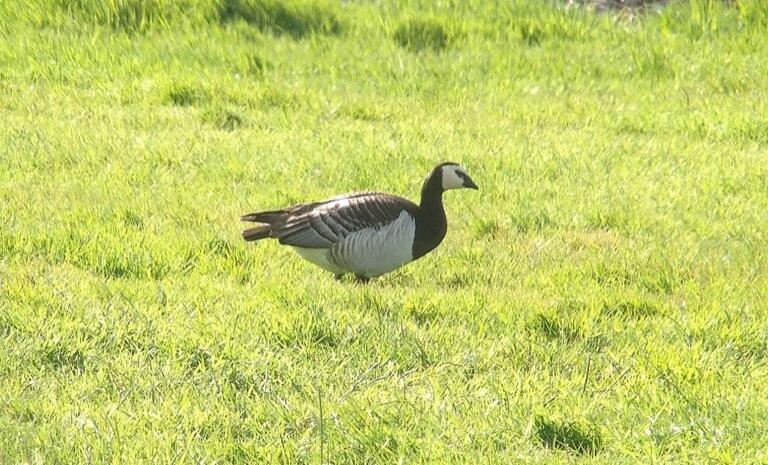
Barred Warbler
Latin Name
Sylvia nisoria
Status
Rare vagrant
Site And Records Information
Studland National Nature Reserve – Two records with sightings on 20th September and 3rd October 1981.
Bean Goose
Latin Name
Anser fabalis
Status
Vagrant
Site And Records Information
This rare goose species only occurs very infrequently and has only occurred in Poole Harbour on six dates, although one of those occurrences was of 14 individuals on Dec 6th 2004 which were confirmed as Tundra Bean Goose. The Frome Valley, Swineham, Bestwall and Arne Moors would be classic places to look during the winter in amongst the Canada and Greylag Goose flocks.
5 “secured for eating” on 24th Nov 1876, site unspecified
1 on 11th Dec 1976 in Poole Park
1 from 31st Dec 1982 to 27th Feb 1983 at Swineham
2 on 30th Jan 1994 at Little Sea, Studland then Keysworth. These birds were confirmed as Tundra Bean Geese (A. f. rossicus).
14 on 6th Dec 2004 at Wareham Meadows (D.Liley et al.). The following day they were seen at Middlebere. These birds were confirmed as Tundra Bean Geese (A. f. rossicus).
2 on 6th – 8th Dec 2014 at Swineham (P.Morton, M.J.Lawson et al.) moving briefly to Arne Moors on 7th. These birds were not assigned to species level.
Dec 20th 2021 and remained into 2022.A family party of 2 adults and 1 juvenile were found in Upton CP. They were confirmed as Tundra Bean Geese (Tom Beer)
Jan 1st – 11th March 2022. The family party that arrived in late 2021 at Upton CP remained until mid-March, touring Poole Harbour, being logged at Lytchett Fields, Swineham, Brands Bay, Keysworth and Bestwall
Bearded Tit
Latin Name
Panurus biarmicus
Status
Resident
Site And Records Information
First colonised the harbour in the mid 70’s. Most regularly recorded from Lytchett Bay and Swineham. Breeding has been confirmed at Lytchett Bay, Holton Heath and Arne. Can be eruptive, “A massive immigration in the second half of October 1972” with a maximum of 44 on 17th at Arne. 20- 25 regularly present thereafter to the end of the year. Migrants have been confirmed with 2 Dutch ringed birds controlled at Arne in 1972. The reed beds along the north edge of lytchett Bay are the most productive, certainly in autumn where flocks of 40+ can occur.
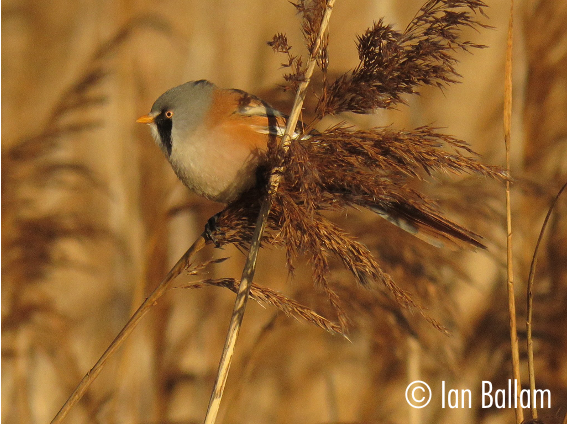
Bee-eater
Latin Name
Merops apiaster
Status
Vagrant
Site And Records Information
Without doubt, Bee-eater is top of every birders target list in spring and is an extreme vagrant to the harbour. Records of this species in Britain are steadily increasing and with breeding taking place on the Isle of Wight in recent years. Hopefully we can look forward to a twitchable bird in the harbour soon. May looks like the best month!
6 on 7th May 1988 at Brands Ford
1 on 9th May 1998 on Ballard Down
3 on 24th May 2009 flew SE over a Broadstone garden (K.E.Lane)
Bewick’s Swan
Latin Name
Cygnus columbianus
Status
Scarce Winter Visitor
Site And Records Information
The fly way population of Bewick’s Swans declined by 27% between 1995 and 2005. The occurrence of the species in southern England has been further effected by mild winters and the species preference to winter in eastern England. Numbers are now very low and appear to depend on the severity of the weather. A wild swan in Poole Harbour is now just as likely to be a Whooper as it is a Bewick’s.
This species used to be regular at Little Sea in the 60’s, since then the water meadows at East Holme has become the most reliable place to see this species with occasional birds wandering to Bestwall at Wareham. A maximum of 40 were seen on 2nd Mar 1980. Whilst 27 were seen flying to roost on the Wareham water meadows with seventeen White-fronted Geese in balmy weather in the evening of Sat 8th Feb 1982. Ringing records showed that most Dorset birds breed in the Pechora Valley in Arctic Russia. They also show how the birds used to move through the Somerset Levels in December then arrive in Dorset early in the year
Records this century:
4 on 13th Feb 2000 at Wareham Water Meadows
4 on 1st Jan 2001 at East Holme
2 on 15th Dec 2002 at East Holme
Up to 14 between 4th Jan and the end Feb 2004 at various sites in the Frome and at Arne
2 from 22nd Jan – 3rd Feb 2006 in the Wareham area
2 on 20th Nov and 1 from 15th Dec 2007 to 2008 at East Holme
1 (the bird above) remained at East Holme until 1st Feb 2008. 1 was then seen at the same site 14th -16th Dec.
4 from 10th – 14th Jan, increasing to 5 on 17th Jan 2010 at East Holme. A single at Middlebere on 10th Jan 2010.
2 on 2nd – 4th Jan 2014 at Wareham Water Meadows.
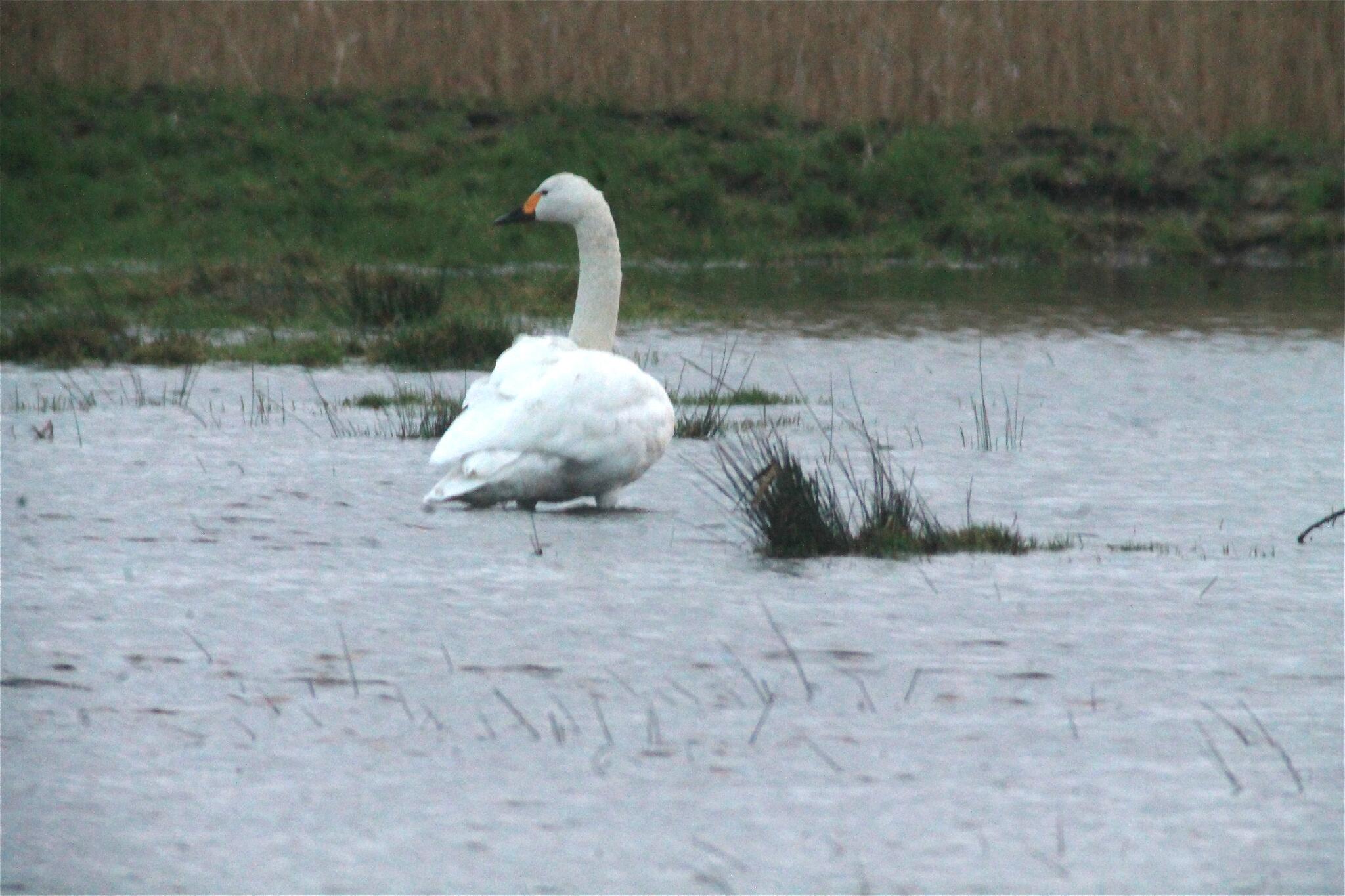
Bittern
Latin Name
Botaurus stellaris
Status
Winter Visitor
Site And Records Information
In 1997, at the start of the EU LIFE Bittern project, only 11 booming males were found in the UK at seven sites. By 2014, there were 140 ‘boomers’ across 61 sites. This has increased again to 150 in 2015. This species is one of Britain’s conservation success stories. The birds visiting Poole Harbour come from far afield. The species does not now breed in Dorset despite having bred historically. The British wintering population is estimated to be c600 with the indigenous population supplemented by migrants from the continent.
Hatch Pond is included in the Poole Harbour recording area and between 1997 and 2013 this species was present every winter. It was relatively easy to see with up to 4 birds regularly over wintering at this very urban site. However for reasons unknown no birds returned in the winter of 2013-14 or 14-15 and to date none have been seen in the winter of 15-16.
Sightings from the rest of the harbour have increased too. Swineham, Middlebere, Arne and Lytchett Bay all have produced records in the last 5 years, whilst its also recently been discovered that by watching reed beds at dusk (especially Swineham) migrant Bittern depart just before sunset, calling to other Bittern in the darkness before lifting up off NE into the darkness. Truly magical. They can often turn up in unusual locations during cold weather with one found in a built up area of Parkstone during the ‘big freeze’ of Jan-Feb 1963. The latest recorded was on 10th May 1946 at Swineham and the earliest was also at Swineham on 21st September 1975.
Recent records
Arne Moors – 1 on 4th Jan and 17th – 18th Feb, 12th – 13th December 2014
Lytchett Bay – 1 13th Jan 2014
Swineham GP – 1 30th Dec 2014
Arne Moors/Swineham area – 3rd, 5th, 7th, 26th January. 9th, 10th February. 25th March. 3rd Nov 2015
Swineham GP – Singles departed at dusk on 7th, 8th and 9th Marsh 2021
Swineham GP – 1 on 3rd Nov 2023
Swineham GPs – 1 on 21st Sep 2023
Black Brant
Latin Name
Branta bernicla nigricans
Status
Vagrant
Site And Records Information
This longed for for species was added to the harbour list on 10th February 2003. It was found from the hide at Arne overlooking the Middlebere Channel and was almost certainly the same bird seen at Stanpit Marsh late in 2002. This bird was also seen at Ower and Middlebere being last recorded on 14th March 2003. In 2004 what was believed to be the same bird was found by at Middlebere on 10th Jan. It was still there next day but was then relocated at Baiter.
This distinctive race breeds in eastern Siberia and western Canada. They are increasingly found with Brent Geese flocks in Britain. As of 30th June 2005 records of this species were no longer reviewed by BBRC.
1 from 10th Feb – 14th Mar 2003 at Middlebere (J.Lidster, B.Spencer et al)
1 on 10th and 17th Nov 2005 at Studland (J. Lidster)
1 from 5th Feb – 27th Mar 2006 at Middlebere (many observers)
1 from 19th Nov until 21st Feb 2007 at Middlebere (T.Elborn, J.Phillips et al ). This bird was also seen at Wytch and Arne. (Presumed returning adult from above)
1 from 16th Jan – 1st Mar 2009 in Studland area (G.Armstrong et al)
1 on 8th – 15th Jan 2017 off Gold Point and Middlebere (N.Hopper et al)
1 on 20th Dec 2017 in Brands Bay (S.Smith)
1 on 21st Feb 2018 at Whitley Lake, Sandbanks (N.Hopper et al)
1 on 4th Nov 2018 in Wareham Channel (N.Hopper)
1 in on 11th – 13th December in Lytchett Bay (S.Robson et al)
There is one additional undocumented record of 1 on 10th – 14th Jan 2004 at Middlebere. This record was noted as pended in 2004 DBR, we would welcome further details on this report. An individual has also spent the winter periods of 2017-2020 in the with the dark-bellied Brent Goose flock along the southern shores of Poole Harbour, wandering occasionally to Evening Hill and the Wareham Channel.
2017
Poole Harbour Single bird at Middlebere on 8th & 14th Jan; also in Brand’s Bay on 20th Dec and at Middlebere on 24th & 28th Dec (P Moore et al).
2018
Poole Harbour The bird first seen in Dec 2018 was seen intermittently at Arne RSPB, Middlebere, Sandbanks and other locations from 1st Jan to 23rd Feb. During the second winter period, 1 was in the Wareham Channel on 4th Nov (N Hopper et al) and an adult at Lytchett Fields RSPB on 11th Dec was the first record for the site (S Robson).
2019
Poole Harbour In the first winter period a single adult remained from 2018 until 5th Mar. During the second winter period single adults were seen near Round Island on 28th Nov (L Bissell et al) and Lytchett Bay on 17th Dec (S Robson et al).
2020
Poole Harbour In the first winter period a single bird remained from 2019 favouring the south shore between Goathorn and Ower on 19th– 22nd Jan and on 23rd Feb (Phil Saunders et al). During the second winter period, 1 was in Brand’s Bay on 20th Dec (Steve W Smith et al).
2021
Adult at Shipsatl Beach, RSPB Arne, 27th Jan (P Morton & J Parker et al). Presumably the same returning bird was seen later in the year with 1 at RSPB Arne on October 22nd (A Miller & C Batty) and later seen in the Wareham Channel on October 26th (B Maxted & S Robson)
Black Grouse
Latin Name
Tetrao tetrix
Status
Former Breeding Species, No Recent Records
Site And Records Information
Sadly a bird that no longer breeds on the open heaths of Poole Harbour where it was once an uncommon bird almost 150 years ago. They were Shot out in the last century. “Birds were not uncommonly found on the heaths between Studland and Goathorn” – Mr Clifdon
Black Guillemot
Latin Name
Cepphus grylle
Status
Vagrant
Site And Records Information
An increasing winter visitor to the harbour, seen during winter where they often pitch up at favourite feeding sites for days, sometimes weeks at a time. The south-east corner of Brownsea has been a favoured over-wintering site in recent years, with birds leaving the harbour on a falling tide and feeding out in Shell and Studland Bay.
1 on 4th Feb 1933 in “Poole Harbour”
1 on 27th Dec 1999 in Studland Bay (J.F.Phillips, S. Woolley)
1 from 3rd to 25th Oct 2001 at the harbour mouth (many observers)
1 on 19th to 22nd Nov 2010 nr Furzey Island, Brands Bay and Studland Bay (H.G.Wood-Homer et al)
1 from 13th Dec 2014 to 8th Feb 2015 at the harbour mouth (many observers)
1 on 14th – 23rd Dec 2015 off Brownsea (P.Morton et al). Last winters’ returning bird?
1 on 3rd Jan – Feb 18th 2016 off Brownsea SE shoreline
1 on Nov 13th – 15th 2018 off Brownsea southern shore – (G.Armstrong et al)
1 on Aug 11th 2019 taken into care, found off Bournemouth Pier
Black Kite
Latin Name
Milvus migrans
Status
Vagrant
Site And Records Information
There have been 29 accepted records for Dorset up to 2012 but only 4 accepted records in Poole harbour. This species ceased to be classed as a national rarity by BBRC in 2005. Records are now assessed by the DRP.
1 on 12th and 14th Apr 1981 at Corfe Castle (M.Read, E.Read, R.E.Scott, E.A.Scott et al)
1 on 31st Aug 2014 over Slepe Heath, headed SE towards the harbour mouth (P.Morton)
1 on 31st July 2018 over Slepe Heath (P.Hadrill)
1 on July 2nd and 8th 2021 over Greenlands Farm and Keysworth (A.Brown & C.Newman)
Black Redstart
Latin Name
Phoenicurus ochruros
Status
Passage Migrant & Winter Visitor
Site And Records Information
Ballard Down was the premier site with regular sightings in early spring and late autumn. Other favoured sites include the Knoll/Middle Beach area, Arne Farm, Middlebere, Poole Quay, Old Town Poole and Sterte/Holes Bay but they can, and do, turn up almost anywhere during the autumn and winter even on the Sandbanks Crazy Gold Course like in Nov 2018. They can often be spotted out of office windows during October and November on the old roofs of Old Town Poole, brightening up a dull meeting. Breeding was confirmed in 2022 with a pair nesting in Old Town Poole, successfully raising three chicks.
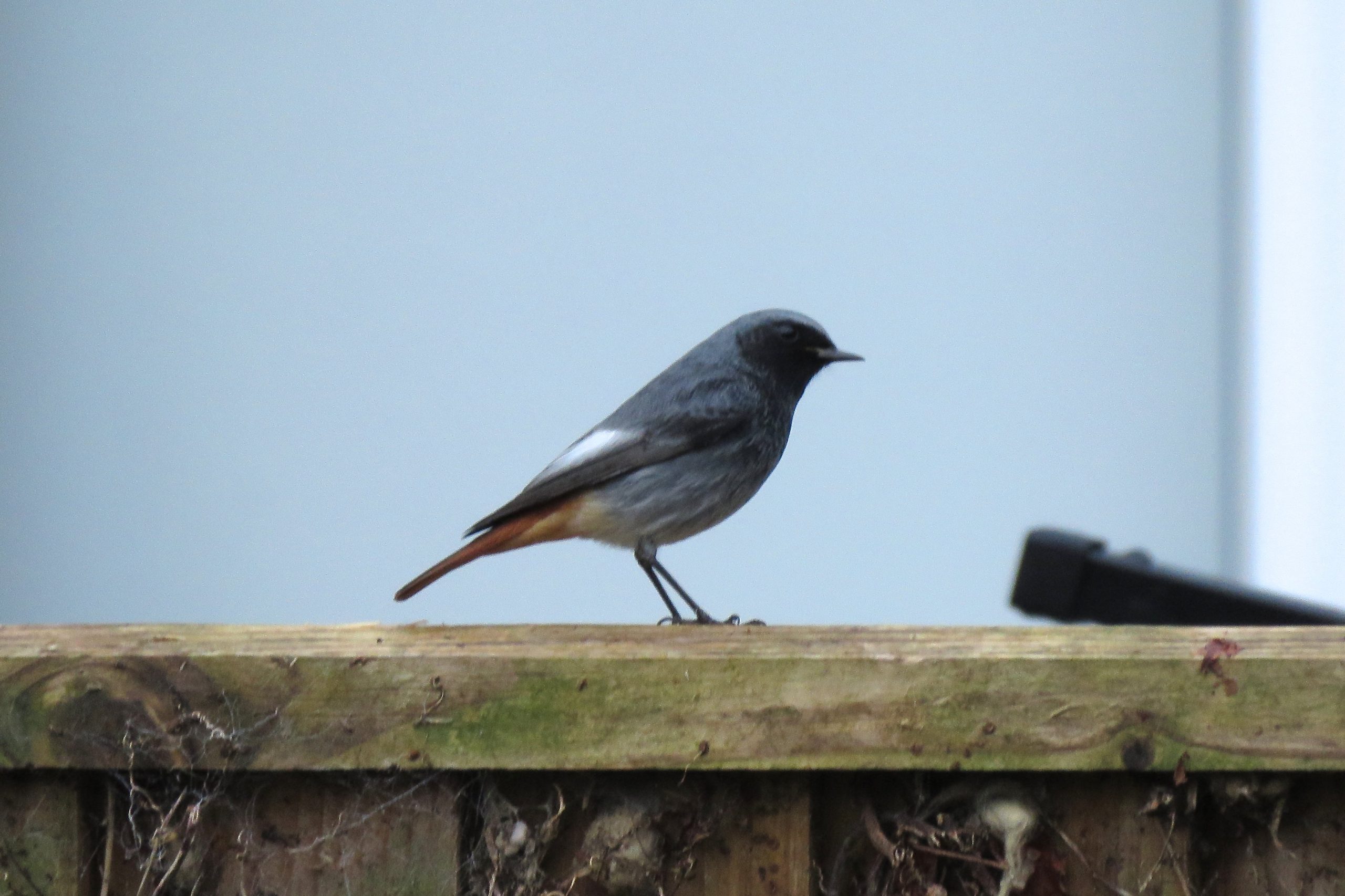
Black Stork
Latin Name
Ciconia nigra
Status
Vagrant
Site And Records Information
Middlebere has 80% of all harbour records for this species, making the ‘NT Harrier Hide’ or Coombe viewpoint at Arne the best place to try and see this rare bird in the harbour.
1 historic report of one shot on 22nd Nov 1839 at Middlebere with another shot there in Nov 1849
1 on 28th May 1977 at Middlebere
1 on 16th Jul 1988 at Arne/Middlebere (A.Gouldstone, C.Kitchen et al)
1 on 1st May 2011 at Lytchett Bay (S.Robson)
1 on 8th – 9th Aug 2015 in Middlebere/Wytch Lake area (many observers)
Black Tern
Latin Name
Chlidonias niger
Status
Scarce Passage Migrant
Site And Records Information
Usually at least one or two records each year mostly in autumn. An average of 4-5 birds per year 2008-2012. However the range was large, from 12 in 2008 to 0 in 2009. Brownsea is a favoured stop off point. More recently Swineham GP has proven attractive. Seawatching from Branksome also offers opportunities in early May. Larger groups can rarely occur with flocks of 10-20 birds in the records at Studland and Holes Bay. An incredible record on the 18th August 1952 saw 1000+ Black Terns arrive in Studland Bay, “these were assembled on the beach at Studland Bay, and at the time consisted of the largest concentration ever recorded in the British Isles”
Black-eared Wheatear
Latin Name
Oenanthe hispanica
Status
Vagrant
Site And Records Information
1 on 25th – 26th Jun 2000 at Upton Heath (many observers). This record of a 1st summer male was accepted as the eastern Mediterranean race O.h.melanoleuca. To some this adjudication remains in dispute and in their minds the case that it was the nominate western race remains open.
There have only been 4 Dorset records of the stunning wheatear. All between 16th May and 26th Jun.
Black-headed Gull
Latin Name
Chroicocephalus ridibundus
Status
Resident
Site And Records Information
Probably one of the most numerous birds in the harbour. Can be encountered on any habitat at any time of year. There is a large breeding colony of c6000 pairs off the Holton shore which it shares with 120+ pairs of Med Gull. Sadly the colonies of Little sea, Studland and Holes Bay are long gone due to the erosion of the spartine marsh they used to nest on.
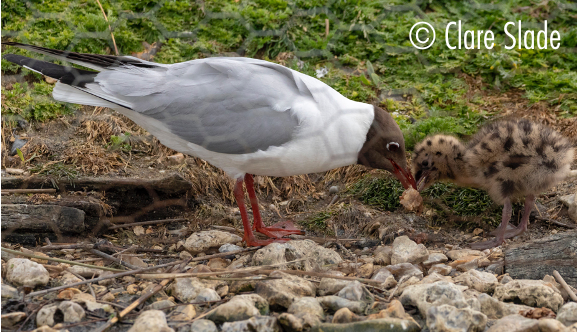
Black-necked Grebe
Latin Name
Podiceps nigricollis
Status
Winter Visitor
Site And Records Information
Poole Harbour hosts nationally important numbers of this species. By far the best place to watch is Studland Bay and Shell Bay with a max count of 81 during the winter of 2010/11. It’s often the most important wintering site in UK. Small groups do move in to the harbour, with the body of water between Brands Bay and Brownsea worth checking as birds swim into roost in the evenings as well as smaller groups out in central harbour that often join the grebe and duck roost off Round Island. The earliest was off Shipstal Point on 16th August 1999 and the latest was on the 3rd May 1992 at Arne.
Birds are most numerous in February when its assumed that numbers are boosted by migrant birds moving north. A major oiling incident in the harbour in 1964 halved the wintering population. A partial recovery occurred in the 80’s and 90’s with a high count of 30 in Studland Bay 8th Feb 1997. Three died and two more were oiled as a result of the 1964 collision.
Recent ‘obscure’ records include 1 on Poole Park boating lake in April 2018, 1 in Lytchett Bay on 29th Dec 2019 and 4 summer plumaged individuals in the Wareham Channel in April 2018 suggesting they were staging migrants passing through the harbour.
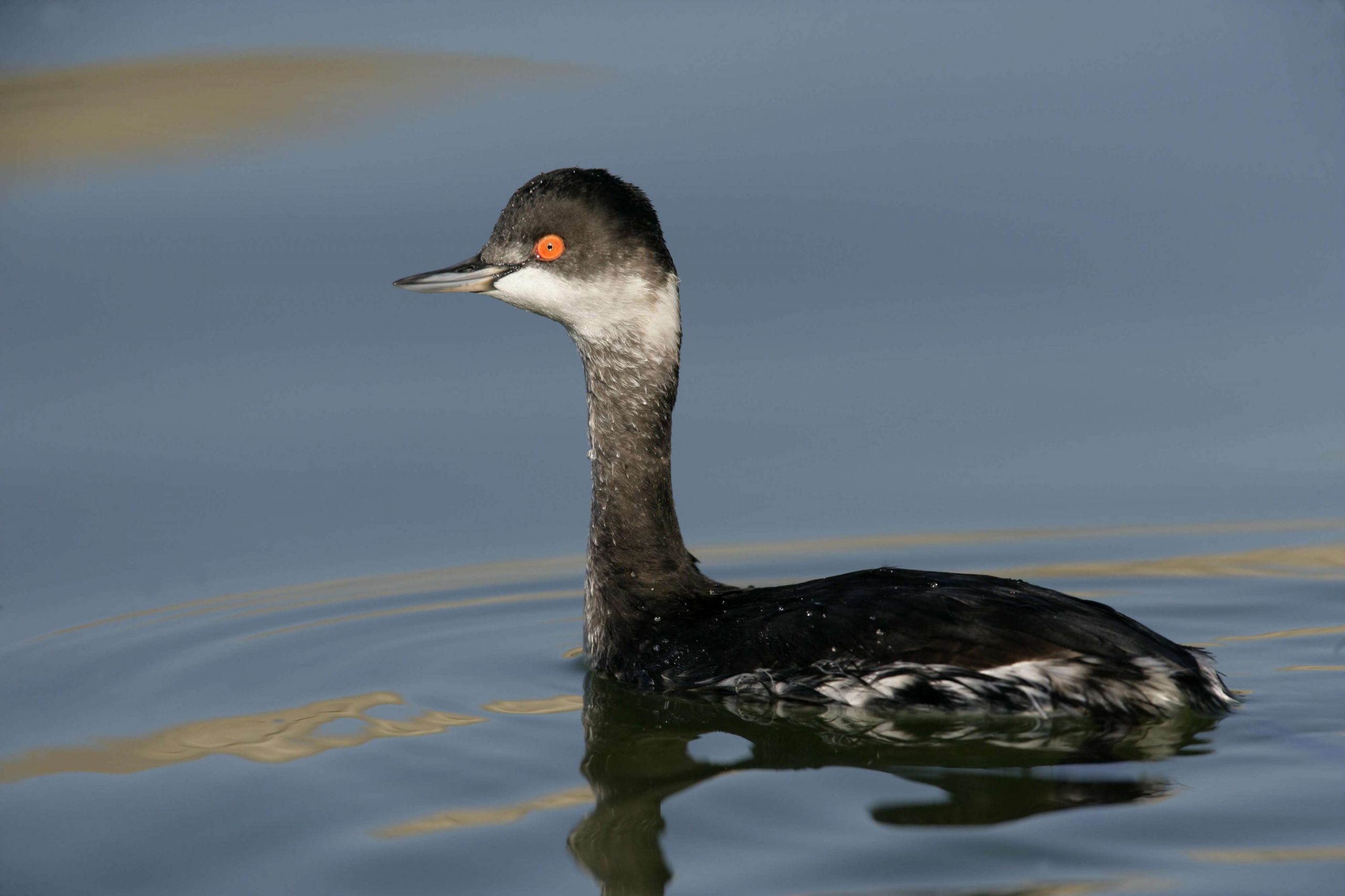
Black-tailed Godwit
Latin Name
Limosa limosa islandica
Status
Resident
Site And Records Information
Poole Harbour is an internationally important site for Black-tailed Godwit. With harbour counts exceeding 2000 it makes them an easily seeable bird in many of the bays and water meadows. Middlebere holds around 300-400 mid winter as does the Brownsea lagoon. Other large flocks can be found in Brands Bay, Lytchett Bay, Holes Bay and Arne Bay. Also found on the water meadows and fields of Bestwall and Swineham all the way up to East Stoke ! There is a regular small flock of summering birds now.
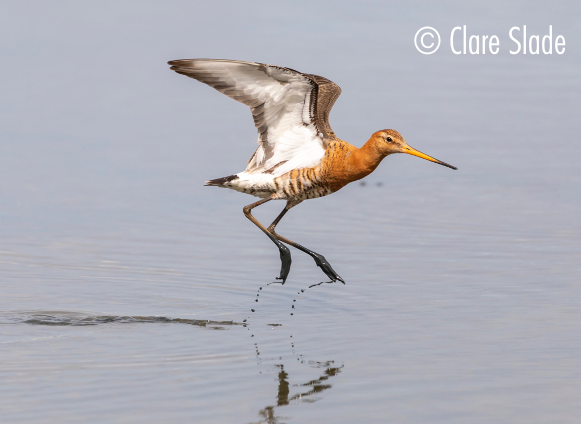
Black-throated Diver
Latin Name
Gavia arctica
Status
Scarce Winter Visitor
Site And Records Information
The least common of the three (main) diver species, they can arrive and spend time in the bays outside the harbour mouth during the winter. They are scarcely recorded in the inner harbour apart from their favourite over-wintering zone seems to be the north channel off Evening Hill and Salterns Marina. In winter can be also be found fishing off Sandbanks just outside the harbour mouth and into Studland Bay, with a maximum of 8 in Poole Bay 7th January 1989. Mainly recorded past Branksome Chine during winter sea watches.
Unseasonal records include individuals on 31st July 1978 and 13th June 1984. One also summered in Poole Bay in 2000 and was present from June to September seen mainly off Branksome Chine.
One on Hatch Pond 21-23 January 1995 was a noteworthy inland record.
Recent records:
2023
North Haven Point – Singles on 16th Jan and 22nd Dec.
Poole Harbour – Singles present on six days between 19th & 24th Jan and on 13 days between 19th Nov and 20th Dec.
Shell Bay – 1 on 9th Jan.
Studland Bay – Single birds reported on 23rd & 28th Jan, 11th & 26th Dec.
Black-winged Stilt
Latin Name
Himantopus himantopus
Status
Vagrant
Site And Records Information
The pattern of occurrence is interesting for Dorset. There are 2 records from the 19th century. Next there were 3 records between 1956 and 1960. 25 years passed before the next (1985) but there were a further 5 by 1990. Another 21 years (2011) passed before the County then enjoyed another 6 records up to the end 2014. There are currently 4 Poole Harbour records…..
1 on 3rd Aug – 6th Sep 1960 at Wareham sewage works found by Helen Brotherton, J Follett and P Partington
1 on 7th Jun 1978 on Brownsea Lagoon
2 on 12th-13th Apr 2014 on flooded fields at Swineham/Bestwall (P.Morton et al)
3 from 21st – 25th May 2014 at Lytchett Fields (I.Ballam et al)
1 on 11th -14th May 2016 at Lytchett Fields (D.Jones et al)
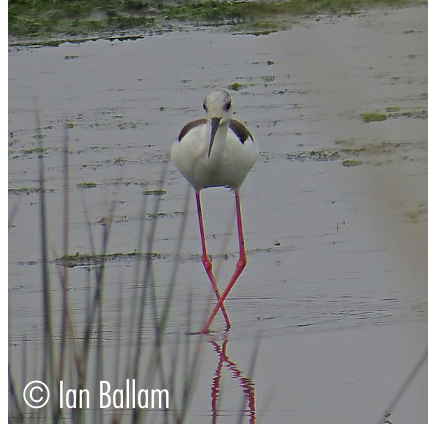
Blackbird
Latin Name
Turdus merula
Status
Resident
Site And Records Information
Common throughout the harbour with numbers rising especially during autumn migration and hard weather. In late October many hundreds (sometimes thousands) can be heard migrating overhead in the darkness in the company of Redwing and Fieldfare. South Haven is a good spot to watch migrating Blackbirds.
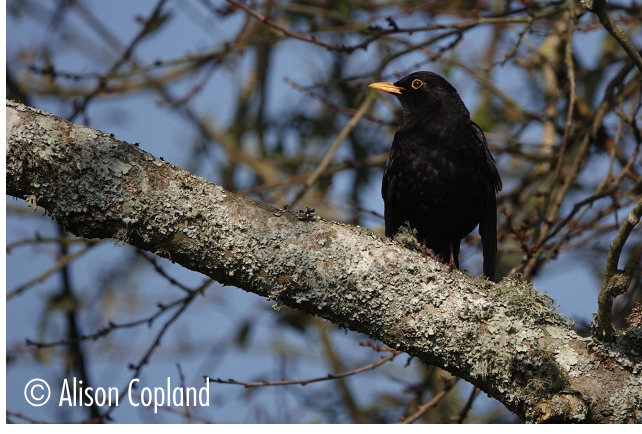
Blackcap
Latin Name
Sylvia atricapilla
Status
Resident
Site And Records Information
Territories are found throughout the woodland bordering the harbour. Poole Park, Upton Country Park, Lytchett Bay, Arne and Studland are regular spots with passage birds flooding through the area in September and October. Regular on migration in scrubby habitats like Ballard, Middlebere, Lytchett Bay, Greenlands Farm and good numbers in the PC World drain during September and October.
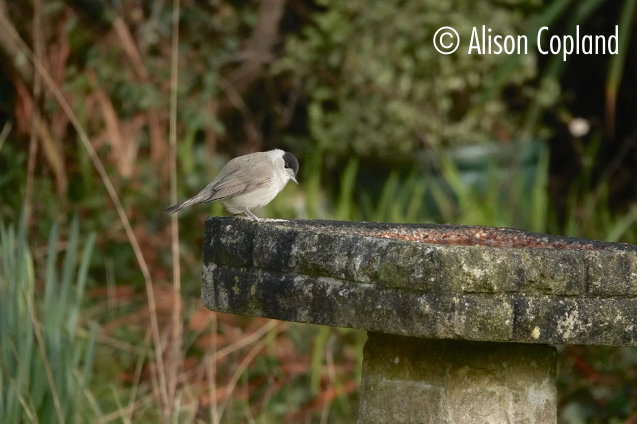
Blue Tit
Latin Name
Cyanistes caeruleus
Status
Resident
Site And Records Information
Found in gardens, parks, woodland, urban and rural areas across the harbour. Common but very very beautiful.
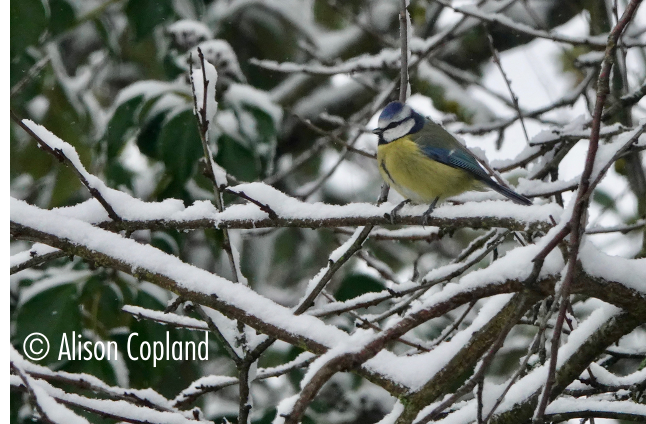
Blue-headed Wagtail
Latin Name
Motacilla flava flava
Status
Scarce Passage Migrant
Site And Records Information
The first Poole Harbour record came from Wareham in on 4th June 1903. It has always been rare and this is demonstrated by the fact that there have only been 5 recent records.
A male on 25th April 1999 at Ballard Down (T Elborn)
A male on 25th April 2013 at Lytchett Bay (S Robson)
A male on 27th April 2013 at Holton Lee (N Hopper)
A female on 22nd April 2014 at Lytchett Bay (I Ballam)
A male on 15th & 19th May 2023 in the Lower Piddle Floods, Swineham
Bluethroat
Latin Name
Luscinia svecica
Status
Vagrant
Site And Records Information
This is a scarce species in Dorset, it does not occur annually. All of the Poole Harbour records are believed to refer to the red-spotted race L.s.svecica. In recent years, early spring influxes of the white-spotted race L.s.cycanecula have occurred, particularly around Portland. The first of these for Poole Harbour is a very realistic prize for local rarity searchers.
1 on 22nd Sep 1960 at Baiter Point
1 on 13th Apr 1968 in Serpentine Road, Poole
1 from 26th to 29th Sep 1971 in the north-west corner of Lytchett Bay
1 (male) on 14th Oct 1984 at Little Sea, Studland
1 on 29th May 1989 at Arne
1 trapped and ringed on 27th Aug 1993 at Keysworth (R.Gifford)
1 trapped and ringed on 29th Aug 2015 at Lytchett Fields, Lytchett Bay (R.Gifford et al)
Bonaparte’s Gull
Latin Name
Chroicocephalus philadelphia
Status
Vagrant
Site And Records Information
One at Brownsea Island was re-identified several hours later from a photograph taken on the afternoon of 30th July 2017 (per Rare Bird Alert). Thankfully it was still present the following morning when it was found feeding on the lagoon (N.Hopper et al). It was still present at the time of writing (2nd Aug) and is thought to have been a 2nd calendar year bird.
1 between 30th Jul and 31st Aug 2017 on the Brownsea Lagoon (L Bissell, N.Hopper et al).
Call 01202 641 003
© 2025 Birds of Poole Harbour Registered Charity No. 1152615
